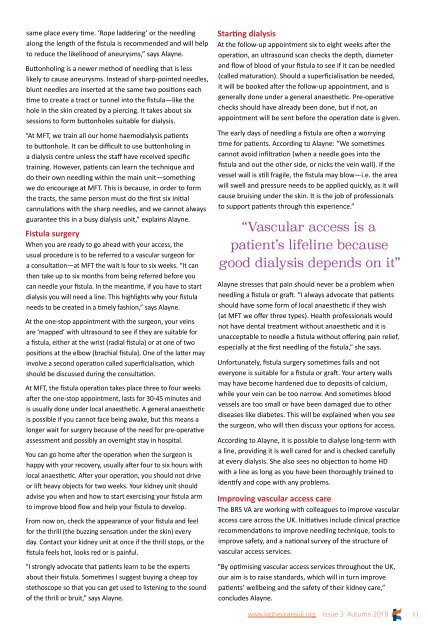You also want an ePaper? Increase the reach of your titles
YUMPU automatically turns print PDFs into web optimized ePapers that Google loves.
same place every time. ‘Rope laddering’ or the needling<br />
along the length of the fistula is recommended and will help<br />
to reduce the likelihood of aneurysms,” says Alayne.<br />
Buttonholing is a newer method of needling that is less<br />
likely to cause aneurysms. Instead of sharp-pointed needles,<br />
blunt needles are inserted at the same two positions each<br />
time to create a tract or tunnel into the fistula—like the<br />
hole in the skin created by a piercing. It takes about six<br />
sessions to form buttonholes suitable for dialysis.<br />
“At MFT, we train all our home haemodialysis patients<br />
to buttonhole. It can be difficult to use buttonholing in<br />
a dialysis centre unless the staff have received specific<br />
training. However, patients can learn the technique and<br />
do their own needling within the main unit—something<br />
we do encourage at MFT. This is because, in order to form<br />
the tracts, the same person must do the first six initial<br />
cannulations with the sharp needles, and we cannot always<br />
guarantee this in a busy dialysis unit,” explains Alayne.<br />
Fistula surgery<br />
When you are ready to go ahead with your access, the<br />
usual procedure is to be referred to a vascular surgeon for<br />
a consultation—at MFT the wait is four to six weeks. “It can<br />
then take up to six months from being referred before you<br />
can needle your fistula. In the meantime, if you have to start<br />
dialysis you will need a line. This highlights why your fistula<br />
needs to be created in a timely fashion,” says Alayne.<br />
At the one-stop appointment with the surgeon, your veins<br />
are ‘mapped’ with ultrasound to see if they are suitable for<br />
a fistula, either at the wrist (radial fistula) or at one of two<br />
positions at the elbow (brachial fistula). One of the latter may<br />
involve a second operation called superficialisation, which<br />
should be discussed during the consultation.<br />
At MFT, the fistula operation takes place three to four weeks<br />
after the one-stop appointment, lasts for 30-45 minutes and<br />
is usually done under local anaesthetic. A general anaesthetic<br />
is possible if you cannot face being awake, but this means a<br />
longer wait for surgery because of the need for pre-operative<br />
assessment and possibly an overnight stay in hospital.<br />
You can go home after the operation when the surgeon is<br />
happy with your recovery, usually after four to six hours with<br />
local anaesthetic. After your operation, you should not drive<br />
or lift heavy objects for two weeks. Your kidney unit should<br />
advise you when and how to start exercising your fistula arm<br />
to improve blood flow and help your fistula to develop.<br />
From now on, check the appearance of your fistula and feel<br />
for the thrill (the buzzing sensation under the skin) every<br />
day. Contact your kidney unit at once if the thrill stops, or the<br />
fistula feels hot, looks red or is painful.<br />
“I strongly advocate that patients learn to be the experts<br />
about their fistula. Sometimes I suggest buying a cheap toy<br />
stethoscope so that you can get used to listening to the sound<br />
of the thrill or bruit,” says Alayne.<br />
Starting dialysis<br />
At the follow-up appointment six to eight weeks after the<br />
operation, an ultrasound scan checks the depth, diameter<br />
and flow of blood of your fistula to see if it can be needled<br />
(called maturation). Should a superficialisation be needed,<br />
it will be booked after the follow-up appointment, and is<br />
generally done under a general anaesthetic. Pre-operative<br />
checks should have already been done, but if not, an<br />
appointment will be sent before the operation date is given.<br />
The early days of needling a fistula are often a worrying<br />
time for patients. According to Alayne: “We sometimes<br />
cannot avoid infiltration (when a needle goes into the<br />
fistula and out the other side, or nicks the vein wall). If the<br />
vessel wall is still fragile, the fistula may blow—i.e. the area<br />
will swell and pressure needs to be applied quickly, as it will<br />
cause bruising under the skin. It is the job of professionals<br />
to support patients through this experience.”<br />
“Vascular access is a<br />
patient’s lifeline because<br />
good dialysis depends on it”<br />
Alayne stresses that pain should never be a problem when<br />
needling a fistula or graft. “I always advocate that patients<br />
should have some form of local anaesthetic if they wish<br />
(at MFT we offer three types). Health professionals would<br />
not have dental treatment without anaesthetic and it is<br />
unacceptable to needle a fistula without offering pain relief,<br />
especially at the first needling of the fistula,” she says.<br />
Unfortunately, fistula surgery sometimes fails and not<br />
everyone is suitable for a fistula or graft. Your artery walls<br />
may have become hardened due to deposits of calcium,<br />
while your vein can be too narrow. And sometimes blood<br />
vessels are too small or have been damaged due to other<br />
diseases like diabetes. This will be explained when you see<br />
the surgeon, who will then discuss your options for access.<br />
According to Alayne, it is possible to dialyse long-term with<br />
a line, providing it is well cared for and is checked carefully<br />
at every dialysis. She also sees no objection to home HD<br />
with a line as long as you have been thoroughly trained to<br />
identify and cope with any problems.<br />
Improving vascular access care<br />
The BRS VA are working with colleagues to improve vascular<br />
access care across the UK. Initiatives include clinical practice<br />
recommendations to improve needling technique, tools to<br />
improve safety, and a national survey of the structure of<br />
vascular access services.<br />
“By optimising vascular access services throughout the UK,<br />
our aim is to raise standards, which will in turn improve<br />
patients’ wellbeing and the safety of their kidney care,”<br />
concludes Alayne.<br />
www.kidneycareuk.org <strong>Issue</strong> 3 <strong>Autumn</strong> <strong>2018</strong> 11


















